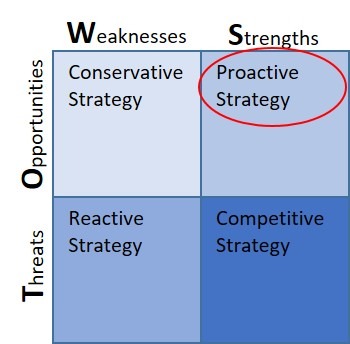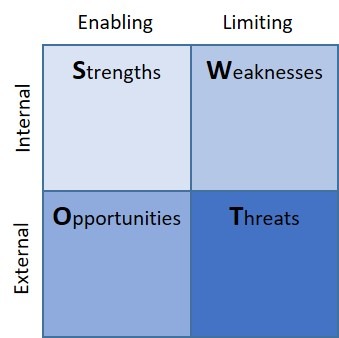Strengths – Weaknesses – Opportunities – Threats
SWOT Analysis
A SWOT analysis is a process that will help Eastern develop a strong strategic plan by insuring we consider all our strengths and weaknesses, as well as the opportunities and threats in the educational landscape.
We will conduct SWOT analysis sessions, across campus, using the Environmental Scan and EWU Guiding Principles as a base documents. Individuals will also bring to the process their personal knowledge, understanding and experience with EWU, the Spokane area, Washington, etc. Participants will be broken into groups, focusing on one area of the SWOT at a time (in a round robin style if appropriate).
Here are some ideas to help with the development of each section of the SWOT analysis. This is not all inclusive and is meant to help get the process started. This is just the beginning of the planning process. The purpose is to take a holistic look at ourselves, to identify our aspirations, and use this information to help inform the development of goals for the strategic plan.
How can we best leverage our strengths and opportunities to achieve success and re-frame our weaknesses and threats to create possibilities and potential?
Accentuate strengths and opportunities. Acknowledge threats and weaknesses. Be open to change and consider your plan dynamic. This will enable your organization to navigate through our ever changing times.
Strategic-Planning-Using-SOAR-and-SWOT-and-SMART-Objectives
Strengths (internal, positive factors)
Describe the positive attributes, tangible and intangible, internal to EWU. They are within our control.
- What do we do well?
- What advantages do we have?
- What do we do better than anyone else?
- What internal resources do we have? In regards to people, knowledge, programs, networks, reputation, skills, technology, etc.
- What advantages do we have over other universities in Washington, the region, the country?
- What other positive aspects, internal to EWU, add value or offer us a competitive advantage?
Weaknesses (internal, negative factors)
Aspects that detract from our ability to accomplish the University’s mission and/or place us at a competitive disadvantage with other universities. We need to enhance these areas in order to serve students and compete with our best competitors.
- What can we improve, what should we avoid?
- How to re frame our weaknesses to what we want instead of what we don’t want – how can they inform our strengths and opportunities?
- What factors that are within our control that detract from our ability to support student success?
- What factors that are within our control that detract from our ability to obtain or maintain a competitive edge?
- What areas need improvement to accomplish our objectives or compete with our strongest competitors?
- Are we lacking anything as a university (for example, expertise, access to skills, resources or technology)?
Opportunities (external, positive factors)
External attractive factors that represent possibilities and reasons EWU is likely to prosper.
- What opportunities exist in our market or the environment that we can benefit from?
- Is the perception of EWU positive?
- What trends are we aware of?
- Student Success
- Recent market growth or other changes in the market that create an opportunity?
- Government policies, changes in social patterns, population profiles, lifestyle changes, etc.
- Local events
- Is the opportunity ongoing, or is there just a window for it? In other words, how critical is timing?
Threats (external, negative factors)
Include external factors beyond our control that could place our strategy, or the university itself, at risk. We have no control over these, but may benefit by having contingency plans to address them if they should occur.
- Who are our existing or potential competitors and what are they doing?
- How can we reframe threats to inform our opportunities and strengths?
- What factors beyond our control could place EWU at risk?
- Are there challenges created by an unfavorable trend or development that may lead to deteriorating retention, persistence or graduation?
- What about shifts in student behavior, the economy, or government regulations that could reduce enrollment, tuition and resources?



